This is my go-to recipe for the best gluten-free pancakes. They come out light and fluffy—with hardly any work required. It’s a simple one bowl recipe. Stir the batter together, let it rest for a few minutes, and then cook them on a hot griddle. That’s it!
Looking for a gluten-free and grain-free pancake recipe? Try these fluffy almond flour pancakes or these cute coconut flour pancakes.

Ingredients Explained
Here’s what you need to make a batch of these pancakes.
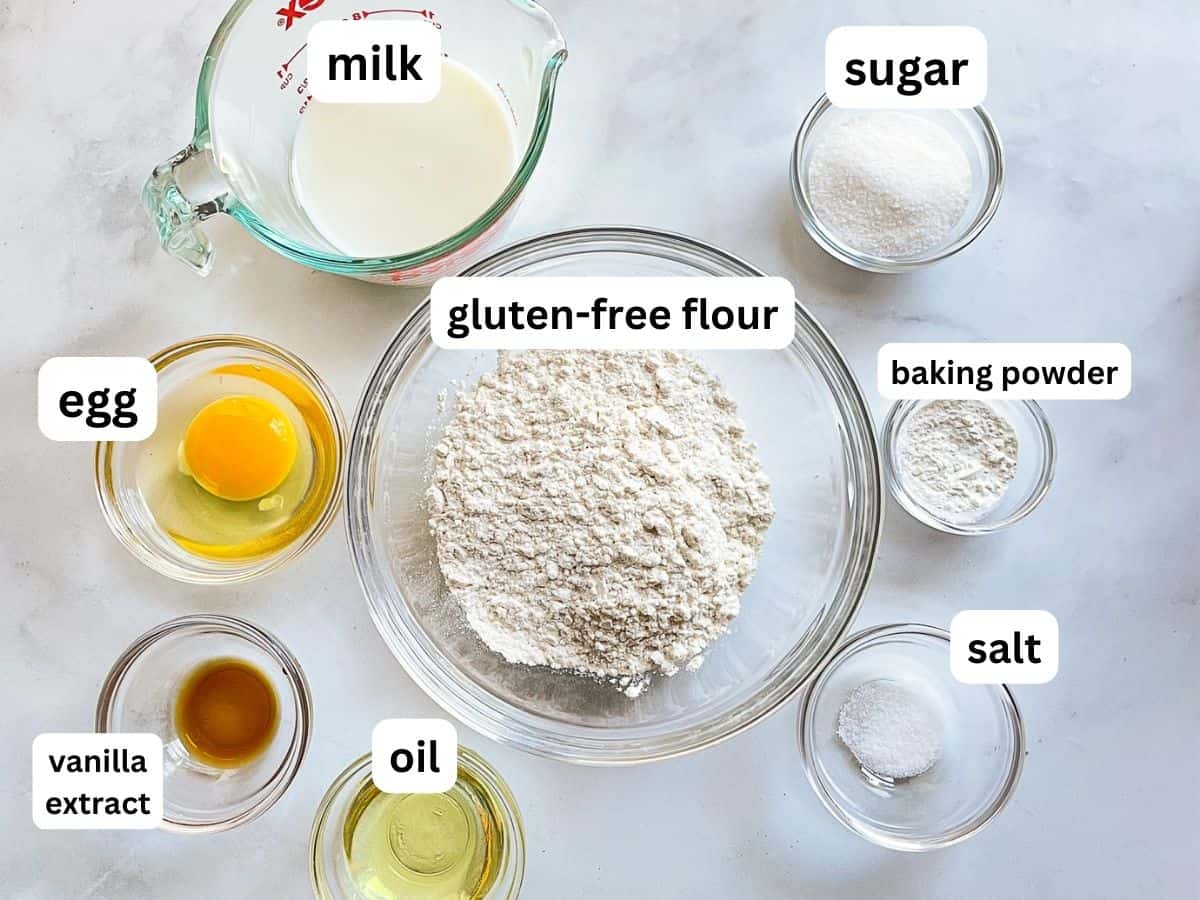
- Gluten-Free Flour. Gluten-free flour blends vary from brand to brand. This recipe was developed with Bob’s Red Mill 1:1 Gluten-Free Flour blend. Using a different blend might change the results.
- Sugar. A little granulated sugar adds a touch of sweetness and helps with browning.
- Egg. One egg does a lot! It adds structure, flavor, and helps with the rise.
- Milk. Use your favorite milk. Both traditional and dairy-free milk work.
- Oil. Oil works great and it’s what I usually use. If you prefer a buttery flavor, use melted butter. Just remember to let it cool a little before adding it to the batter.
- Vanilla Extract. The vanilla adds a nice flavor. Almond or lemon extract can be used too.
- Baking Powder. Makes the pancakes nice and fluffy.
- Salt. Use table salt. It blends easily into the batter.
Variations
If you love blueberry or chocolate chip pancakes, you can use this recipe to make them! For an extra pop of flavor, make a batch of blueberry-chocolate chip pancakes. The two flavors go great together.
- Blueberry Pancakes: Stir ½ cup of fresh or thawed blueberries into the batter.
- Chocolate Chip Pancakes: Replace the granulated sugar with light brown sugar and sprinkle a few chocolate chips onto the batter immediately after you spoon the batter onto the griddle. Serve with a dollop of whipped cream.
How to Make Gluten-Free Pancakes
This recipe is so easy you can make a batch while still half asleep. Grab a bowl, whisk everything together, and cook. That’s it! No whipping egg whites. Just light and fluffy pancakes that gluten-free eaters will gobble up.
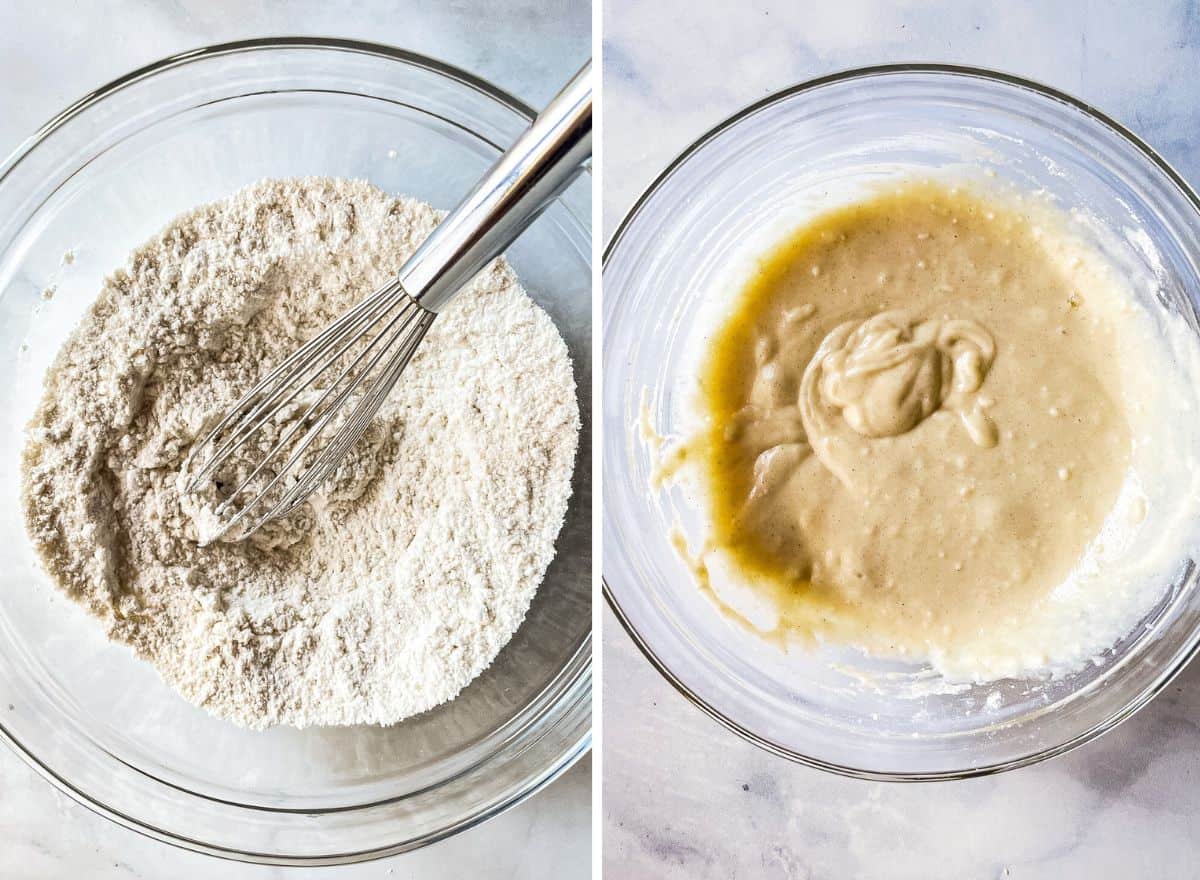
Step One: Make the Batter.
First whisk the dry ingredients together. This evenly distributes the sugar, baking powder, and salt within the gluten-free flour, ensuring that each pancake rises and browns uniformly.
Then add the wet ingredients. Mix until the batter is smooth. You might see a lump here and there. That’s fine.
Run a spatula along the bottom and sides of the bowl. If you see any dry flour, stir it gently into the batter.
Step Two: Let the Batter Rest.
After you mix it, let the batter rest (sit on the counter) for between 5 and 15 minutes. This helps the gluten-free flours and starches fully absorb the liquid.
Since it thickens a little during the rest, give the batter a stir right before cooking. If it’s too thick to drop from a spoon, stir in a tablespoon or so of milk.

Step Three: Cook on a Hot Griddle.
The key to great gluten-free pancakes is to cook them on a hot greased griddle. Oil your pan with a light brush of oil or a spray of nonstick cooking spray.
When your pan is hot-but not smoking-spoon about a ¼ cup of batter onto it.
Cook the pancakes for about two minutes. When you see a few bubbles on the surface of the pancake, it’s time to flip them. Then cook for another minute or so.
How to Flip a Pancake
There’s a bit of an art to flipping a pancake. Here’s how to do it.
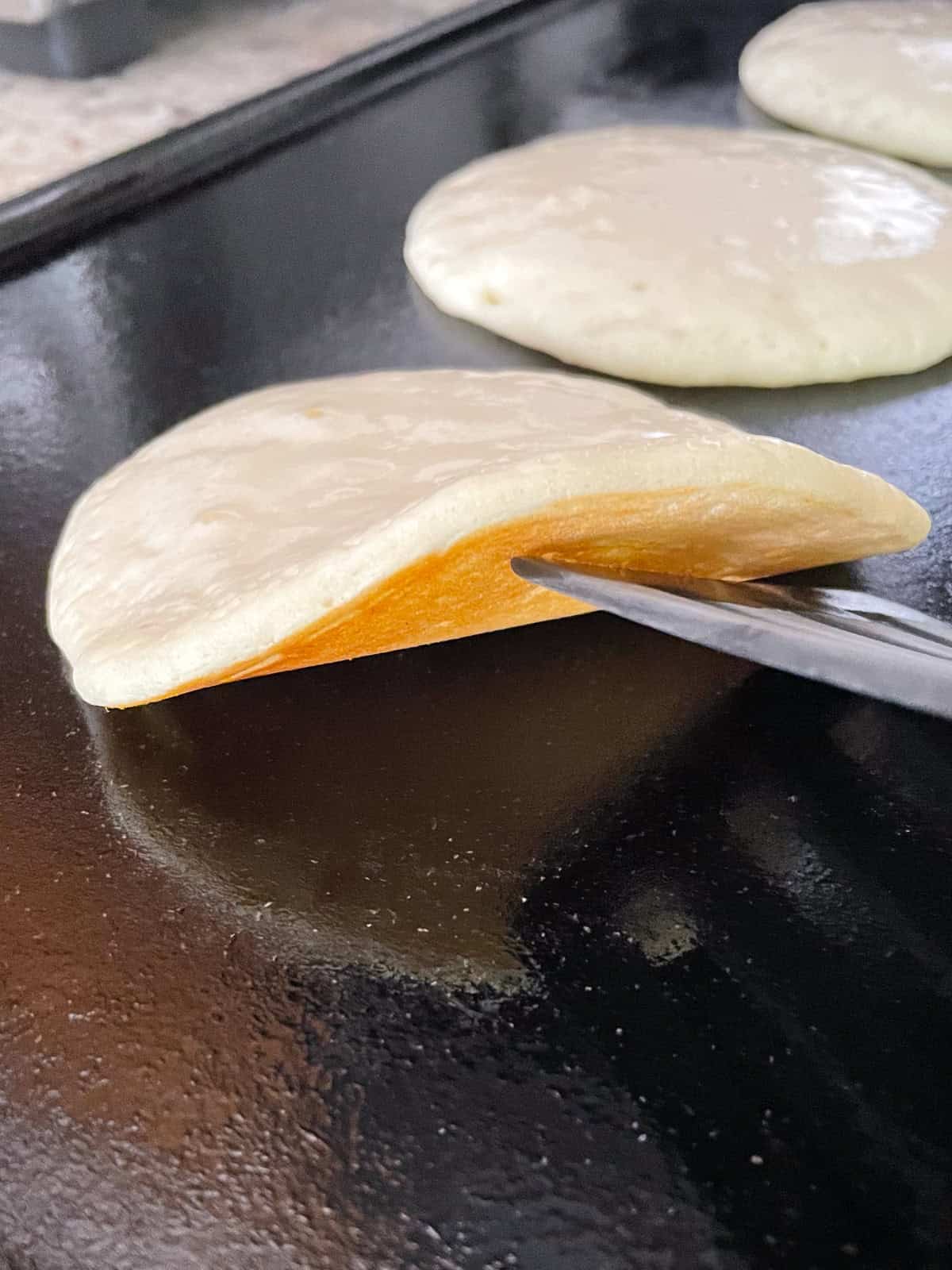
- Heat and grease the griddle. If you cook pancakes on a cold pan, they won’t brown or rise nicely. And if your pan isn’t nicely greased, they’ll stick. Nonstick and cast iron griddles are perfect for gluten-free pancakes! If you’re using an electric griddle, heat it to 350℉.
- Leave space. First, remember that it’s hard to flip a pancake on a crowded griddle! Leave about an inch between each pancake.
- Wait for bubbles. Look for the batter to lose a little of its shine and for bubbles to appear on the surface.
- Use a the right spatula. The best spatula for flipping a pancake is a large one with a thin edge. If the spatula is too small, it’s hard to get under the pancake to flip it.
- Take a peek! I like to gently slide the spatula under the pancake and carefully lift the edge. I give it a quick peek to see if it’s brown. If it’s still pale, I let it cook for another minute or so.

- Flip gently. Lift the pancake a little. There’s no need to lift it very high off the pan. Then, using your wrist, quickly flip the pancake. Think of it more like a turn, than a flip.
- Cook until brown. After you flip, the pancake only needs a minute or so more to cool. You can gently tap the top to make sure it’s set and not soft.
Keeping Pancakes Warm
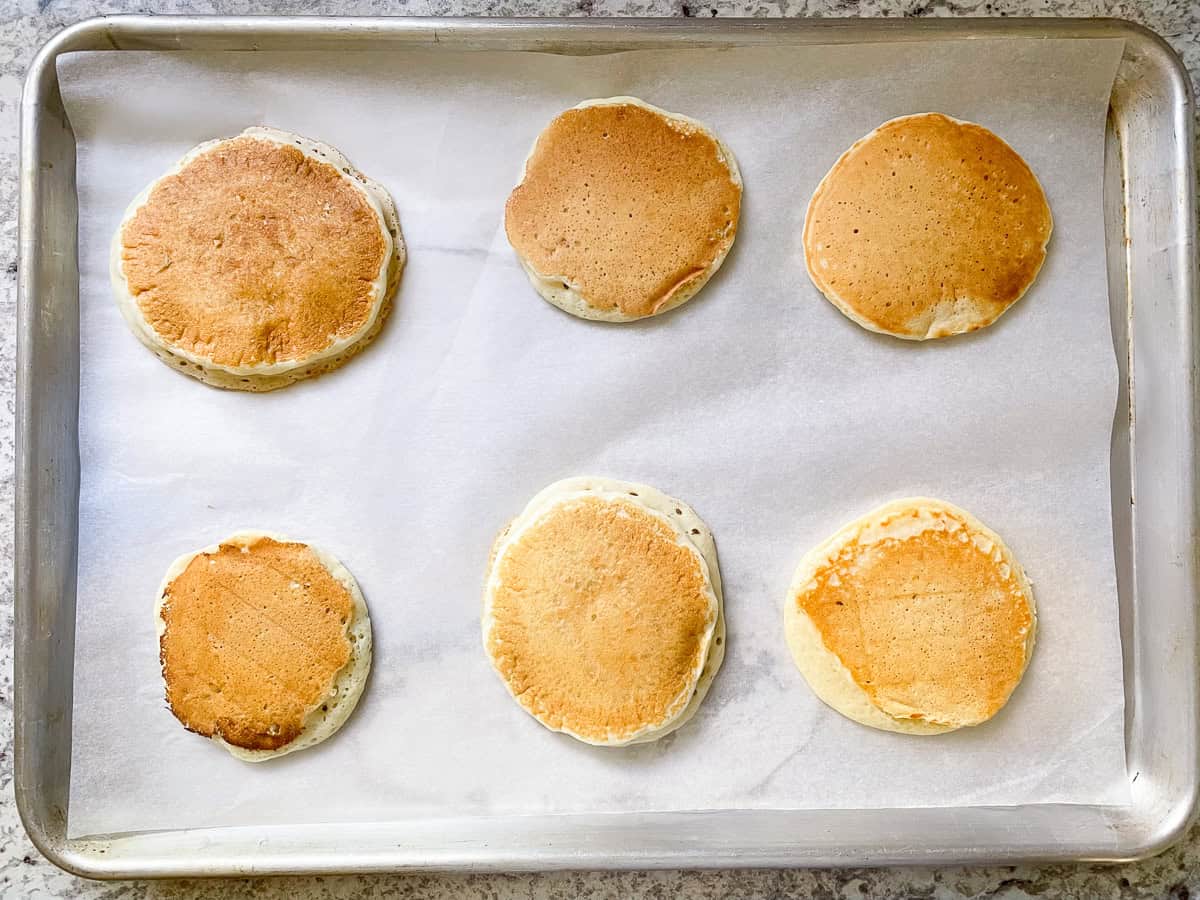
Place a parchment-lined baking sheet into the oven before you mix the pancake batter. Heat your oven to 225°F. As you make the pancakes, transfer them to the warm baking sheet. Pancakes keep for about 30 minutes in a warm oven. After that, they start to dry out.
Storing and Reheating Leftovers
If you’ve got leftover pancakes, lucky you! They’re great for a quick gluten-free breakfast.
Store the leftover pancakes covered at room temperature for a day. They tend to dry out. So I recommend freezing leftovers.
Freezing
Place cooled pancakes into a freezer bag or container. If you’re going to stack them, put a piece or waxed or parchment paper between them.
They keep for about two months in the freezer.
Reheating
When you’re ready to eat, you’ve got options!
- Microwave. Place frozen pancakes in a single layer on a microwave-safe plate. Heat on medium-high for one minute. Flip the pancakes and heat for another 30 seconds or until warm. The reheating time will vary depending on your microwave.
- Air Fryer. Place the frozen pancakes in a single layer on the tray of your air fryer.
- Oven. If you need to reheat a lot of pancakes, the oven is the best method. Heat the oven to 325℉. Place the frozen pancakes on a baking sheet. Heat until warm, this usually takes about 10 minutes.
Note: This recipe was originally published in 2017. It has been updated to use a gluten-free flour blend. Here is the link to the original gluten-free pancake recipe.

Fluffy Gluten-Free Pancakes
These gluten-free pancakes are incredibly light and fluffy. For the best texture and rise, let the batter rest for at least five minutes before cooking. A hot, greased skillet ensures the pancakes don’t stick.
Ingredients
- 1 cup gluten-free flour (Bob's Red Mill 1:1 Gluten-Free Baking Flour recommended) (5 ounces; 142 grams)
- 2 tablespoons granulated sugar (1 ounce; 28 grams)
- 1 ½ teaspoons baking powder
- ½ teaspoon salt
- ¾ cup milk (6 ounces; 170 grams)
- 1 large egg (2 ounces; 56 grams)
- 2 tablespoons oil or melted butter (1 ounce; 28 grams)
- ½ teaspoons vanilla extract
Instructions
-
Whisk the gluten-free flour, sugar, baking powder, and salt together in a medium bowl. Add the milk, egg, oil, and vanilla extract. Let the batter rest for 5 minutes. (Batter can rest up to 30 minutes.)
-
Heat a nonstick griddle or skillet over medium-high heat. Lightly grease the griddle with oil or butter.
-
Spoon about ¼ cup of batter onto the skillet. Cook until the edges look set and bubbles appear all over the surface of the pancake, about two minutes. To check for doneness, lift the edge of the pancake with a spatula. It should be golden brown.
-
Flip the pancake and cook until golden brown, about two additional minutes.
Repeat with the remaining batter. Serve with butter and syrup.
To Keep Pancakes Warm
-
Before making the batter, place a parchment-lined baking sheet in the oven. Heat oven to 225°F.
Transfer cooked pancakes to the baking sheet. Don't overlap the pancakes. Keep warm for up to 30 minutes.
Recipe Notes
Ingredients and Substitutions
Gluten-Free Flour. For best results, use a gluten-free flour blend that contains xanthan or guar gum. If your blend doesn’t, whisk in ¼ teaspoon. The recipe was tested with Bob’s Red Mill 1:1 Gluten-Free Flour Blend.
Milk. If you want to make gluten-free and dairy-free pancakes, use dairy-free milk.
Egg. Use a large egg. If you’d like gluten-free and egg-free pancakes, use an egg replacer and follow the directions on the package for replacing one egg. Please note: I tested the recipe using Bob’s Red Mill’s egg replacer and a flax egg. Both work. The pancakes made with Bob’s egg replacer turned out a bit lighter than those made with the flax egg. Both were a little heavier than pancakes made with an egg. Since egg-replacers vary from brand-to-brand, use your favorite.
Oil. Any neutral oil, like corn or canola oil, works. Melted butter may also be used. After melting the butter, let it cool for a few minutes before adding it to the batter.
Freezing and Reheating
Place pancakes in a freezer bag or container. To keep them from sticking, place a piece of waxed or parchment paper between each pancake.
To reheat in the microwave: heat on low power for one minute. Flip and heat an additional minute as needed.
To reheat in the oven: Preheat the oven to 325℉. Place frozen pancakes on a baking sheet. Heat for about 10 minutes.
For additional information, including air fryer and toaster directions, see above.
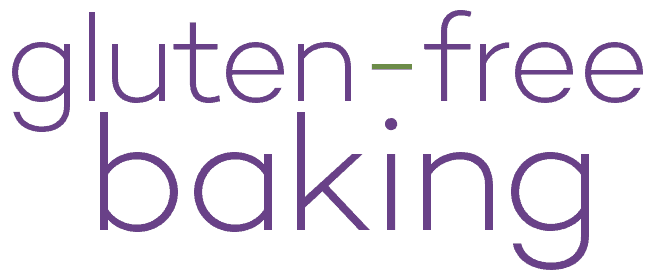


missylou says
I really love buckwheat pancakes. Could buckwheat be added to these or substituted? If so, how much and/or for which ingredient? Thanks.
Elizabeth says
Yes, buckwheat would work. (Be sure to use buckwheat that’s labeled gluten-free.) I’d replace the white rice flour with buckwheat. If you’d like a milder flavor, use half white rice flour and half buckwheat.
Enjoy!
Simone says
Hi there! Is corn starch the same as cornflour? I’m in Australia so I’m not sure if we just call it cornflour. Thanks so much!
Elizabeth says
Yes! It’s the same ingredient!
Pam says
Could you substitute arrowroot or tapioca or something else for the cornstarch? We are also trying to avoid corn products.
Elizabeth says
Pam–
For this recipe, I’d use potato starch. Tapioca starch would work but I find it adds more structure. So I’m worried it would make tough pancakes.
Mary Scott says
I am a diabetic like almost 50 % of the population (which means most likely 50% of the people like myself that have celiac or gluten intolerance have some form of diabetes) so rice, corn, potato and any most other starches/flours are not really permissable as they raise our blood sugar. This includes any ingredient labeled maltodextrin as it is made from wheat or corn. I have substituted tapioca flour in this recipe for the rice flour and it does not change the texture to me and it tastes good too. The Brazilians only use tapioca flour to make pancakes and waffles in their recipes. Most of their cooking seems to be gluten free – even the breads and diabetic friendly too.
There are 2 types of tapioca flour – one is sweet and one is sour. I have found that I have the same problem with the sour as I do wheat and the sweet is hard to find so I am in the process of trying millet, sweet white sorghum, quinoa and white teff flours to see how they do with this recipe. Thank you so much for making it available to us.
Elizabeth says
Hi Mary,
Glad you had success with the recipe using tapioca starch!
Just to clarify, according to the American Diabetes Association, about 9.3% of the US population currently has diabetes and between 5% and 10% of the celiac population has diabetes.
If you are looking for recipes free of most grains, check out my paleo recipes. They most use almond and coconut flour. Many of readers with diabetes really enjoy the recipes.
As for the tapioca starch, sour tapioca starch is very hard to find in the United States. Most brands are the traditional “sweet” tapioca starch. So if you’re looking for it, Bob’s Red Mill sells tapioca starch.
Have fun playing with the recipe! It’s very adaptable! 🙂
Mary Scott says
Thank you so much for your citation of information from the American Diabetes Association. ” Prevalence: In 2012, 29.1 million Americans, or 9.3% of the population, had diabetes.” from the ADA website which was up from 25.8 in 2010. It goes on to say: “Approximately 1.25 million American children and adults have type 1 diabetes. Undiagnosed: Of the 29.1 million, 21.0 million were diagnosed, and 8.1 million were undiagnosed. 1.4 million Americans are diagnosed with diabetes every year.”
Unfortunately this does not track with the numbers between 2010 and 2012 which is more like 3.5 million in a 2 year period. Also not included in these numbers are the people that are Pre-diabetic (readings of 100 to 140) at 86 million who also should be watching their eating habits. This totals 29.1+86.0 (pre-diabetic) million or 115 million effected Americans in 2012 This makes the percentage 35% in 2012 Also not in their numbers are the people that do not take insulin and use diet and supplements to control the problem.
My doctor, Dr Panitch of Chicago, Il, told me that the medical information he receives from his medical doctors group he is part of states: “Frighteningly, 7 million people are diabetic and don’t even know it because the symptoms develop so gradually. And the problem is accelerating.” The numbers of those of us that are not on insulin by using natural diet and supplements like the program I am on are also missing. Our program alone in the Chicago area is 27,000 participants that started in the program in 2014 alone and now totals over 100,000+ in 2016 since the program started in 2012. I actually was advised by the National Kidney Foundation testing program that I needed medical attention for possible diabetes done in 2013 locally for free. So as you can see why I make the statement that about 50% of the population has some form of diabetes: Pre, Type 1, Type 2
My gastroenterologist tells me that 1 % of the population are celiac but the number goes up astronomically because of gluten interolerance. He also said that he is finding more and more of his patients having both the gluten interolerance and being diagnosed with diabetes every day. Since the numbers of diabetics grossly out number the gluten interolerant people it only makes sense that if when we are adjusting recipes for the gluten that we also take the diabetes into consideration for those that have not realized they have the problem yet.
Thank you for the correction on the tapioca type most found in the US. I have to order the one I do not have a problem with (evidentially the sour) from a company that ships from Brazil and didn’t look at my orders before responding previously..
Elizabeth says
No problem! Glad you found the information on tapioca starch helpful.
The rise of diabetes, all types, is alarming and should be taken seriously. I develop a wide range of recipes and not all my recipes will be the right fit for everyone.
Happy Baking! 🙂
Eva says
Can I use almond milk instead of normal milk? I’m trying to avoid dairy.
Elizabeth says
Yes! Absolutely!
Leilani Richards says
These were so yummy. I did substitute tapioca flour for the sweet flour as I did not have any sweet rice flour at home. They were so fluffy and incredably good. It will be a go to for a very long time.
Thanks
Elizabeth says
Glad you enjoyed them!
Millie Olson says
Could I use either whole grain flour, or all purpose flour or tapioca flour for all the flour? I would rather not use rice flour. Thank you
Elizabeth says
Whole grain or all purpose gluten-free flour, yes. Tapioca flour, no. That will not work.
Chantelle says
These pancakes ARE the best! I’ve made the recipe before and loved it, but this time I had to sub a few ingredients for what I had, and they were still the BEST! THANK YOU, Elizabeth! I purchased your paleo baking cookbook and the ‘easiest cookies’ are the ‘easiest’ and delicious. Looking forward to trying more of your creations.
Elizabeth says
So glad you enjoyed the pancakes!
Jolene says
I accidentally put 1 cup flour and forgot to halve the other ingredients and it STILL worked – I made mini pikelets and they were fluffy and delicious. I don’t know how you do it but the two recipes I’ve used so far are fantastic, especially for a rubbish cook like me.
Gember88 says
Can I make ebelskivers (Danish Filled Pancakes) with this. I have the pan since going gluten free I haven’t been successful in finding a pancake recipe that I can use to make ebelskivers.
Elizabeth says
I’d try it with one change. I’d separate the eggs and whip the whites. Then fold the whites into the batter. Let me know how it goes!
Patti says
I want to thank you for the fabulous recipe. Our grandson is particular about his pancakes and we have never found a recipe he has liked until this one! You made our day! Thank you!
Brendon says
I’ve made these a couple times and the batter has been very thick both times. I end up with something that resembles biscuits more than pancakes and I have no idea what’s going wrong. I’ve never had any problems with your other recipes.
Elizabeth says
That’s so odd! What flours are you using?
Anon says
I made these this morning and they were PERFECT! I did make a few small changes – I halved the sugar, used butter in the pancake mix instead of vegetable oil, dropped the xanthan gum, and swapped corn starch for arrowroot powder. I also altered everything with a weight (rice flours, starch, etc.) to match what my brands of flours/starch define as a cup, half cup, etc. I figured using the weights listed about would make the batter too runny. At half a cup of batter each, we ended up with six good-sized pancakes! The first two burned a little; once I got the temperature under control they cooked up just right 🙂 I have tried a lot of pancake recipes over the years, and this is hands down the best one. Even better than wheat ones!
Alene says
I hate to complain because it was probably my fault! I used Cup4Cup gluten free flour that already contains zanthum gum. I usually have pretty good results when I use it, but it could have been why my pancakes were so dense . When I put them in the frying pan, I couldn’t change the shape at all. Of course, when I use a gluten free flour, I still use the scale and couldn’t for this one. They tasted good, but they were thick. My husband commented that the pancakes were just a vehicle for maple syrup, lol.
Next time, I guess, I will make them as you wrote the recipe. I was just too lazy this morning. And how are your pancakes so perfectly round? Do you use a ring to shape them? I couldn’t coax them into any recognizable shape! By the way, I do appreciate your doing this first so we don’t have to make 10 batches to get one good one!
Elizabeth says
Yes, using a different flour blend, especially one that already contains xanthan gum would have greatly affected the recipe.
I don’t use a ring of any kind when making the pancakes. The batter is a nice consistency. It spreads into a circle when it hits the griddle. From the sounds of it, your batter contained too much gum. That would make the batter very thick.
Joanne Thomas says
You never gave the recipe only the method for the pancakes using gluten free flour & xantham gun.
Elizabeth says
Hi Joanne,
The entire recipe is include in the post. Just scroll down to see it. It should be right above where you left this comment. 🙂
Ann says
I’m new to gluten free baking. I bought a lot of brown rice flour. Can I use it in this recipe?
Thanks.
Elizabeth says
Absolutely!
Barbara says
Hi Elizabeth, can I check whether it is possible to use one type of rice flour (equivalent to 2 cups) rather than two separate types?
Elizabeth says
Yes, it will work. The texture of the pancakes will be a little different but the recipe will work!
Sharon says
Thank you for this pancake recipe. They are truly AMAZING!! THE BEST!! ? so light and fluffy.
Poet says
These are AMAZING! I didn’t have GUAR or XANTHAN On hand so I used some tapioca starch (2 tablespoons) I have on hand. The pancakes aren’t as fluffy as I like but they have a lovely slightly sweet taste to them. I think my next batch I will omit the milk and use some unsweetened coconut milk I have on hand.
Elizabeth says
Glad you enjoyed them. I’ve made them with both xanthan gum and without. The xanthan makes them fluffier. Without it, the pancakes are good but a little flat.
Olga Genua says
Hello,I love this recipe!I didn’t have a white rice flour,so I substituted half tapioca half potato starch. Its came out a little liquidy so I decided to make crepes- its come out perfect!The only I want to adjust sugar- and it would be perfect to stuff it with any filling- apples,cottage, cheese, meat,caviar!Thank you so much!!!
Elizabeth says
Glad you enjoyed it! Yes, replacing the rice flour with tapioca and potato starch would have made for a much looser batter.